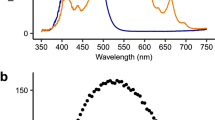Abstract
Earlier laboratory experiments suggested that environmental levels of UV-B radiation can damage the eyes of barnacle naupliar larvae and impair their phototactic behaviors. However, since barnacle larvae may avoid UV by migrating to deeper waters, it is not known whether such impairment would actually occur under field conditions. For the first time, this study provides both field and laboratory evidences to show that prevailing UV-B in the natural habitat of barnacle larvae could be an important environmental factor affecting natural barnacle populations. We here showed that although barnacle nauplii may avoid UV-B irradiation by downward migration, the amount of UV energy (9.8 × 10−6 J) received by a naupliar eye during downward migration in the natural water column is within the same order of magnitude as the total energy (7.5 × 10−6 J) sufficient to cause damages to naupliar eye and impair their phototactic responses. It is possible that solar UV-B prevailing at shallow waters would pose a similar threat to other zooplankton species over large geographic scale.






Similar content being viewed by others
References
Aitchison J (1986) The statistical analysis of compositional data—monographs on statistics and applied probability. Chapman and Hall, London
Bollens SM, Frost BW (1990) UV light and vertical distribution of marine planktonic copepod Acartia hudsonica Pinhey. J Exp Mar Biol Ecol 137:89–93
Bothwell ML, Sherbot DMJ, Pollock CM (1994) Ecosystem response to solar ultraviolet-B radiation: influence of trophic-level interactions. Science 265:97–100
Bouwman AF (1998) Environmental science—nitrogen oxides and tropical agriculture. Nature 392:866–867
CCPC (Centre for Coastal Pollution and Conservation) (2003) Development of a biological indicators system for monitoring marine pollution. Final report (agreement no. CE 2/2001(EP), submitted to Environmental Protection Department, Hong Kong Government). Centre for Coastal Pollution and Conservation, City University of Hong Kong, Hong Kong
Chiang WL, Au DWT, Yu PKN, Wu RSS (2003) UV-B damages eyes of barnacle larvae and impairs their photo-responses and settlement success. Environ Sci Technol 37:1089–1092
Hallberg E, Elofsson R (1983) The larval compound eye of barnacles. J Crustac Biol 3:17–24
HKEPD (Hong Kong Environmental Protection Department) (2002) Marine water quality in Hong Kong in 2001. Environmental Protection Department, Government of the Hong Kong Special Administrative Region, Hong Kong
Hsu KJ, Yung YL (1999) Ozone trend over Taiwan from TOMS data. Terr Atmos Ocean Sci 10:619–632
Johnson RA, Wichern DW (1992) Applied multivariate statistical analysis, 3rd edn. Prentice-Hall, Englewood Cliffs
Kauri T (1962) On the frontal filaments and nauplius eye in Balanus. Crustaceana 4:131–142
Lam KS, Ding A, Chan LY, Wang T, Wang TJ (2002) Ground-based measurements of total ozone and UV radiation by the Brewer spectrophotometer #115 at Hong Kong. Atmos Environ 36:2003–2012
Macho G, Molares J, Vázquez E (2005) Timing of larval release by three barnacles from the NW Iberian Peninsula. Mar Ecol Prog Ser 298:251–260
Newchurch MJ, Yang E-S, Cunnold DM, Reinsel GC, Zawodny JM, Russell III JM (2003) Evidence for slowdown in stratospheric ozone loss: first stage of ozone recovery. J Geophys Res Atmos 108(D16):4507
Pyefinch KA (1949) Short-period fluctuations in the numbers of barnacle larvae, with notes on comparisons between pump and net plankton hauls. J Mar Biol Assoc UK 28(2):353–370
Rex M, Salawitch RJ, von der Gathen P, Harris NRP, Chipperfield MP, Naujokat B (2004) Arctic ozone loss and climate change. Geophys Res Lett 31:L04116
Roy S (2000) Strategies for the minimization of UV-induced damage. In: de Mora S, Demers S, Vernet M (eds) The effects of UV radiation in the marine environment. Cambridge University Press, Cambridge, pp 177–205
UNEP (United Nations Environment Programme) (1992) UNEP/GEMS environmental library no. 7: the impact of ozone-layer depletion. United Nations Environment Programme, Nairobi
Waibel AE, Peter T, Carslaw KS, Oelhaf H, Wetzel G, Crutzen PJ, Poschl U, Tsias A, Reimer E, Fischer H (1999) Arctic ozone loss due to denitrification. Science 283:2064–2069
Walley JL (1969) Studies on the larval structure and metamorphosis of Balanus balanoides (L.). Philos Trans R Soc Lond Ser B 256:237–280
WHO (World Health Organization) (1994) Environmental health criteria 160: ultraviolet radiation. World Health Organization, Geneva
WMO (World Meteorological Organizationa) (1999) Scientific assessment of ozone depletion: 1998, global ozone research and monitoring project—report no. 44. World Meteorological Organization, Geneva
WMO (World Meteorological Organizationb) (2003) Scientific assessment of ozone depletion: 2002, global ozone research and monitoring project—report no. 47. World Meteorological Organization, Geneva
Wu RSS (1975) The distribution of littoral barnacles in Hong Kong. In: Morton BS (ed) Pacific Science Association, special symposium on marine sciences. Government Printer, Hong Kong, pp 146–153
Wu RSS (1999) Biology of barnacles and control of biofouling in cooling water system, HEC biofouling report. Centre for Coastal Pollution and Conservation, City University of Hong Kong, Hong Kong
Wu RSS, Levings CD (1979) Energy flow and population dynamics of barnacle Balanus glandula. Mar Biol 54:83–89
Wu RSS, Lam PKS, Zhou BS (1997) A phototaxis inhibition assay using barnacle larvae. Environ Toxicol Water Qual 12:231–236
Zar JH (1996) Biostatistical analysis, 3rd edn. Prentice-Hall, Upper Saddle River
Acknowledgments
The work described in this paper was supported by a grant from the Research Grants Council of the Hong Kong Special Administrative Region, China (Project no. CityU 1091/01M) and a grant from CityU (Project no. 7001649).
Author information
Authors and Affiliations
Corresponding author
Additional information
Communicated by O. Kinne, Oldendorf/Luhe.
Rights and permissions
About this article
Cite this article
Chiang, WL., Wu, R.SS., Yu, P.KN. et al. Are barnacle larvae able to escape from the threat of UV?. Mar Biol 151, 703–711 (2007). https://doi.org/10.1007/s00227-006-0508-9
Received:
Accepted:
Published:
Issue Date:
DOI: https://doi.org/10.1007/s00227-006-0508-9




